Pipeline companies constantly assess the growth and demand for energy to project when and where new capacity for transporting energy products is needed. Following is a general discussion of the steps involved in the placement of new energy transmission pipelines to serve growing population centers as well as commercial and industrial needs.
Overview
Planning for new capacity must begin far in advance of transporting the first barrel of oil or refined petroleum product, or the first cubic foot of natural gas. Pipeline companies must determine possible routes for the new pipelines; acquire the rights-of-way (ROW) to build, operate and maintain the lines; engineer the actual system designs; and, construct the lines. All of these steps are subject to rigorous regulatory reviews and approvals. Construction can only begin after the route selection receives regulatory approval, ROW is obtained, and the system design is completed.
Regardless of the length of the pipeline, the construction process must be carefully planned to ensure the safety and integrity of the new pipeline, and then executed to meet construction schedules and seasonal weather conditions. In some ways, installing a pipeline is much like an assembly-line process, with sections of the pipeline being completed in a sequence of repetitive steps.
Route Selection
 Pipeline construction requires a great deal of planning, consultation and preparation. Companies must determine market demand and confirm customer support before investing in a project. Following the decision to move ahead with a project, the company must assess alternative routes for the pipeline, and select a final proposed route. Issues such as what communities need service; what size pipeline is needed; what natural resources might be impacted; what environmental areas and population centers might be intersected; and what other infrastructure systems lie along the route are just a few considerations that enter into the process.
Pipeline construction requires a great deal of planning, consultation and preparation. Companies must determine market demand and confirm customer support before investing in a project. Following the decision to move ahead with a project, the company must assess alternative routes for the pipeline, and select a final proposed route. Issues such as what communities need service; what size pipeline is needed; what natural resources might be impacted; what environmental areas and population centers might be intersected; and what other infrastructure systems lie along the route are just a few considerations that enter into the process.
The general public and government agencies along the proposed route are also consulted, individually and through public notices and public meetings. Extensive environmental and land use assessments are completed, and mitigation plans are formulated for various scenarios. These assessments may result in adjustments to the proposed pipeline route. Following final route selection, land is acquired by purchase, license or easement agreement, and permits are obtained from government agencies with jurisdictions along the right-of-way. Finally, a number of regulatory processes must be completed.
Regulatory Processes
The Federal Energy Regulatory Commission (FERC), exercises regulatory control over construction of natural gas pipelines. Once a gas pipeline company proposes the route or location, it is examined and considered by FERC. The company must study a number of alternative routes or locations to avoid or minimize damage to the environment, and then FERC, interveners, or any commenter may suggest alternatives and modifications.
Effects on buildings, fences, crops, water supplies, soil, vegetation, wildlife, air quality, noise, safety, landowner interests, and more, are taken into consideration. FERC also considers whether a pipeline can be placed near or within an existing pipeline, power line, or highway or railroad right-of-way.
If a determination is made that the project will make no significant environmental impact, the project usually moves forward quickly. However, when it is determined that the project will make a significant environmental impact, a more in-depth environmental impact statement is developed, and acceptable mitigation efforts must be reviewed and approved prior to moving forward. FERC publishes informative material concerning the siting and construction of natural gas pipelines. One is a brochure entitled, "An Interstate Natural Gas Facility On My Land?". Federal regulatory approval is not ordinarily required for development of a new hazardous liquids (oil) pipeline, unless it will cross federal lands. Generally, state and local laws are the primary regulatory factors for construction of new hazardous liquid pipelines.
Design
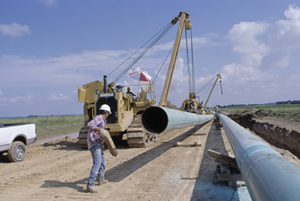 There are many significant differences between hazardous liquid and natural gas transmission pipeline systems. These differences involve system design, materials and components used, safety and environmental considerations, and a host of other topics. Also, an entire transmission pipeline system may be short - such as a lateral line from a production area to a refinery or processing facility - or it may be very long, running from the coast of Texas to a major city in the Northeast.
There are many significant differences between hazardous liquid and natural gas transmission pipeline systems. These differences involve system design, materials and components used, safety and environmental considerations, and a host of other topics. Also, an entire transmission pipeline system may be short - such as a lateral line from a production area to a refinery or processing facility - or it may be very long, running from the coast of Texas to a major city in the Northeast.
Pipe sections are fabricated in steel rolling mills and inspected to assure they meet government and industry safety standards. Generally between 40 and 80 feet in length, they are designed specifically for their intended location in the pipeline. A variety of soil conditions and geographic or population characteristics of the route will dictate different requirements for pipe size, strength, wall thickness and coating material.
Site Preparation
To begin construction the selected route (construction rights-of-way) of the pipeline must be cleared. Construction work and equipment passage requires that temporary work space be used that is outside the permanent easement. The temporary use of this additional space is negotiated with the landowner. A survey crew carefully surveys and stakes the construction rights-of-way to ensure that only the pre-approved construction workspace is cleared.
Next, to make the rights-of-way into a suitable work area, a clearing and grading crew prepares the corridor so the construction equipment can operate safely. This crew removes trees, boulders, brush, and other impediments that may prohibit construction. This crew also prepares a working surface for the additional construction equipment that will follow.
The crew installs silt fence along edges of streams and wetlands to prevent erosion of disturbed soil. Trees inside the right-of-way are cut down and the timber is removed or stacked alongside the rights-of-way. Brush is commonly shredded or burned. Also, as may be necessary in agricultural areas, topsoil may be stripped to a predetermined depth and stockpiled along the sides of the rights-of-way. Stockpiling of topsoil is not required in areas that are not cultivated.
Stringing the Pipe
Once the construction rights-of-way has been cleared sufficiently to allow construction equipment to gain access, sections of pipe are laid out along the rights-of-way. This process is called 'stringing' the pipe.
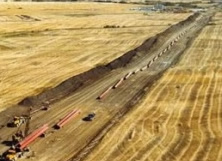
Pipe sections are fabricated in steel rolling mills and inspected to assure they meet applicable industry and federal government safety standards. The fabricated pipe sections are commonly from 40 to 80 feet long. Their design and manufacture are selected specifically for their intended location in the pipeline. This is because specific locations along a pipeline system may have different requirements for pipe size, pipe strength and wall thickness, and coating material due to varying soil conditions, geographical features or nearby population densities.
The pipe may be transported from the pipe mill to a pipe storage yard in the vicinity of the pipeline location or directly to the rights-of-way. After the pipe is delivered to the rights-of-way, a stringing crew will carefully distribute the various pipe sections according to the design plan.
Trenching
After stringing the pipe sections in place, a trench is dug along the rights-of-way alongside the pipe sections. Topsoil is often removed from the work area and stockpiled separately to be used in site restoration. Mechanical equipment such as wheel trenchers or backhoes is used to dig the pipe trench. Occasionally, rock drilling and blasting is required to break rock in a controlled manner. The material that is excavated during trenching operations is temporarily stockpiled on the non-working side of the trench. This material will be used again in the backfill operation.
The trenches are dug deep enough to allow for an adequate amount of cover when the pipe is buried. Federal regulations require that transmission pipelines be buried at least 30 inches below the surface in rural areas and deeper in more populated areas. In addition, the pipeline must be buried deeper in some locations, such as at road crossings and crossings of bodies of water, and may be less in other locations such as when it is installed in consolidated rock. The depth of burial of the line must be in accordance with Federal pipeline safety regulations.
Bending
A bending machine is used in the field to make slight bends in individual sections of the pipe to account for changes in the pipeline route and to conform to the topography. The bending machine uses a series of clamps and hydraulic pressure to make a very smooth, controlled bend in the pipe. All bending is performed in strict accordance with federally prescribed standards to ensure integrity of the bend.
Often bend configurations must be determined ahead of time. They are then pre-engineered and prefabricated in a special shop and then brought on site for installation at the proper location.
Welding
To carry out the welding process, the pipe sections are temporarily supported along the edge of the trench and aligned. The various pipe sections are then welded together into one continuous length, using manual, semiautomatic or automatic welding procedures. Special pipeline equipment called side booms are used to pick up, support and align each piece of pipe with the next piece to make the first pass of each weld.
All welding procedures are qualified and welding is controlled to strict specifications, including semiautomatic and automatic procedures. More and more often, especially for larger projects, automatic welding is used instead of manual welding.
As part of the quality-assurance process, each welder must pass qualification tests to work on a particular pipeline job, and each weld procedure must be approved for use on that job in accordance with federally adopted welding standards. Welder qualification takes place before the project begins. Each welder must complete several welds using the same type of pipe as that to be used in the project. The welds are then evaluated by placing the welded material in a machine and measuring the force required to pull the weld apart. It is interesting to note that the weld is actually stronger than the pipe itself.
A second level of quality-assurance ensures the quality of the ongoing welding operation. To do this, qualified technicians take X-rays of the pipe welds to ensure the completed welds meet federally prescribed quality standards. The X-ray technician processes the film in a small, portable darkroom at the site. If the technician detects any flaws, the weld is repaired or cut out, and a new weld is made. Another form of weld quality inspection employs ultrasonic technology.
Coating
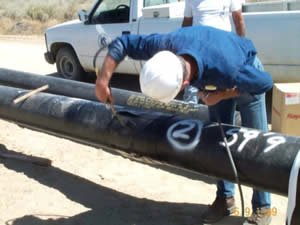 After the pipe is welded, the welds are examined, usually by X-ray, and a coating is applied to the welded areas at the ends of the pipe sections to prevent corrosion. A coating is applied to the pipe during its manufacture; however, this process typically leaves the ends of the pipe uncoated to allow for welding.
After the pipe is welded, the welds are examined, usually by X-ray, and a coating is applied to the welded areas at the ends of the pipe sections to prevent corrosion. A coating is applied to the pipe during its manufacture; however, this process typically leaves the ends of the pipe uncoated to allow for welding.
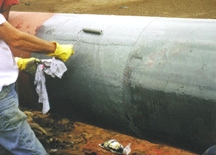
Several different types of coatings may be used to coat field joints, the most common being fusion bond epoxy or polyethylene heat-shrink sleeves. Prior to application, the bare pipe is thoroughly cleaned to remove any dirt, mill scale or debris. The coating is then applied and allowed to dry. After field coating and before the pipe is lowered into the trench, the entire coating of the pipe is inspected to ensure that it is free from defects.
Lowering and Backfilling
Once the pipeline is welded and coated, it is lowered into the trench. Lowering is done with multiple pieces of specialized construction equipment called sidebooms. This equipment acts in tandem to lift and lower segments of the assembled pipeline into the trench in a smooth and uniform manner to prevent damaging the pipe.
Once the pipeline is lowered into the ground, the trench is carefully backfilled, to ensure that the pipe and its coating are not damaged. This is generally accomplished with either a backhoe or padding machine depending on the soil makeup.
Care is taken to protect the pipe and coating from sharp rocks and abrasion as the backfill is returned to the trench. In areas where the ground is rocky and coarse, the backfill material is screened to remove rocks or the pipe is covered with a material to protect it from sharp rocks and abrasion. Alternatively, clean fill may be brought in to cover the pipe. Once the pipe is sufficiently covered, the coarser soil and rock can then be used to complete the backfill.
As the backfill operations begin, the excavated material is returned to the trench in reverse order, with the subsoil put back first, followed by the topsoil. This ensures the topsoil is returned to its original position.
Testing
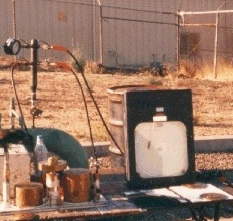 Generally, but with certain exceptions, all newly constructed hazardous liquid and natural gas transmission pipelines must be hydrostatically tested before they can be placed into service. The purpose of a hydrostatic pressure test is to eliminate any defect that might threaten the pipeline's ability to sustain its maximum operating pressure, or to determine that no defects exist. A pipeline is designed to a specified strength based on its intended operating pressure. Hydrostatic pressure testing consists of filling the pipeline with water and raising the internal pressure to a specified level above the intended operating pressure. Critical defects that cannot withstand the pressure will fail. Upon detection of such failures, the defects are repaired or the affected section of the pipeline is replaced and the test resumed until the pipeline "passes".
Generally, but with certain exceptions, all newly constructed hazardous liquid and natural gas transmission pipelines must be hydrostatically tested before they can be placed into service. The purpose of a hydrostatic pressure test is to eliminate any defect that might threaten the pipeline's ability to sustain its maximum operating pressure, or to determine that no defects exist. A pipeline is designed to a specified strength based on its intended operating pressure. Hydrostatic pressure testing consists of filling the pipeline with water and raising the internal pressure to a specified level above the intended operating pressure. Critical defects that cannot withstand the pressure will fail. Upon detection of such failures, the defects are repaired or the affected section of the pipeline is replaced and the test resumed until the pipeline "passes".
Hydrostatic testing is not the only means for detecting pipe defects. For example, inline inspection (ILI) technologies are used that permit the identification of specific types of defects, such as corrosion. But because not all lines can be inspected with ILI tools and because of the need to find types of defects that are not currently detected by ILI technology, hydrostatic testing is an accepted method for demonstrating the fitness of a pipeline segment for service.
Site Restoration
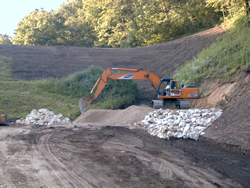 Finally, the construction right-of-way is restored as closely as possible to its original condition. Depending on the location and circumstances, this could involve smoothing the construction area, replacing topsoil, repairing irrigation systems, applying fertilizer and grass seed, or other actions that may be necessary.
Finally, the construction right-of-way is restored as closely as possible to its original condition. Depending on the location and circumstances, this could involve smoothing the construction area, replacing topsoil, repairing irrigation systems, applying fertilizer and grass seed, or other actions that may be necessary.
 The right-of-way is carefully graded, and in hilly areas, erosion-prevention measures such as interceptor dikes - which are small earthen mounds constructed across the right-of-way to divert water - are installed. Stone or timber materials -- known as 'riprap" -- are also sometimes installed along streams and wetlands to stabilize soils and retain habitat following construction.
The right-of-way is carefully graded, and in hilly areas, erosion-prevention measures such as interceptor dikes - which are small earthen mounds constructed across the right-of-way to divert water - are installed. Stone or timber materials -- known as 'riprap" -- are also sometimes installed along streams and wetlands to stabilize soils and retain habitat following construction.













